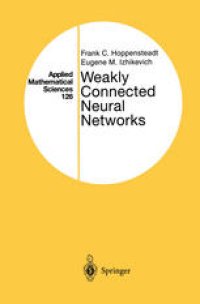
Ebook: Weakly Connected Neural Networks
- Tags: Analysis, Mathematical and Computational Biology, Neurosciences
- Series: Applied Mathematical Sciences 126
- Year: 1997
- Publisher: Springer-Verlag New York
- Edition: 1
- Language: English
- pdf
This book is devoted to an analysis of general weakly connected neural networks (WCNNs) that can be written in the form (0.1) m Here, each Xi E IR is a vector that summarizes all physiological attributes of the ith neuron, n is the number of neurons, Ii describes the dynam ics of the ith neuron, and gi describes the interactions between neurons. The small parameter € indicates the strength of connections between the neurons. Weakly connected systems have attracted much attention since the sec ond half of seventeenth century, when Christian Huygens noticed that a pair of pendulum clocks synchronize when they are attached to a light weight beam instead of a wall. The pair of clocks is among the first weakly connected systems to have been studied. Systems of the form (0.1) arise in formal perturbation theories developed by Poincare, Liapunov and Malkin, and in averaging theories developed by Bogoliubov and Mitropolsky.
This book is devoted to local and global analysis of weakly connected systems with applications to neurosciences. Using bifurcation theory and canonical models as the major tools of analysis, it presents systematic and well motivated development of both weakly connected system theory and mathematical neuroscience. Bifurcations in neuron and brain dynamics, synaptic organizations of the brain, and the nature of neural codes are among the many important issues addressed. The authors offer the reader classical results as well as some of the most recent developments in the field. The book will be useful to researchers and graduate students in various branches of mathematical neuroscience.
This book is devoted to local and global analysis of weakly connected systems with applications to neurosciences. Using bifurcation theory and canonical models as the major tools of analysis, it presents systematic and well motivated development of both weakly connected system theory and mathematical neuroscience. Bifurcations in neuron and brain dynamics, synaptic organizations of the brain, and the nature of neural codes are among the many important issues addressed. The authors offer the reader classical results as well as some of the most recent developments in the field. The book will be useful to researchers and graduate students in various branches of mathematical neuroscience.
Content:
Front Matter....Pages i-xvi
Front Matter....Pages 1-1
Introduction....Pages 3-24
Bifurcations in Neuron Dynamics....Pages 25-101
Neural Networks....Pages 103-110
Introduction to Canonical Models....Pages 111-139
Front Matter....Pages 141-141
Local Analysis of WCNNs....Pages 143-187
Local Analysis of Singularly Perturbed WCNNs....Pages 189-207
Local Analysis of Weakly Connected Maps....Pages 209-218
Saddle-Node on a Limit Cycle....Pages 219-245
Weakly Connected Oscillators....Pages 247-293
Front Matter....Pages 295-295
Multiple Andronov-Hopf Bifurcation....Pages 297-309
Multiple Cusp Bifurcation....Pages 311-335
Quasi-Static Bifurcations....Pages 337-351
Synaptic Organizations of the Brain....Pages 353-379
Back Matter....Pages 381-402
This book is devoted to local and global analysis of weakly connected systems with applications to neurosciences. Using bifurcation theory and canonical models as the major tools of analysis, it presents systematic and well motivated development of both weakly connected system theory and mathematical neuroscience. Bifurcations in neuron and brain dynamics, synaptic organizations of the brain, and the nature of neural codes are among the many important issues addressed. The authors offer the reader classical results as well as some of the most recent developments in the field. The book will be useful to researchers and graduate students in various branches of mathematical neuroscience.
Content:
Front Matter....Pages i-xvi
Front Matter....Pages 1-1
Introduction....Pages 3-24
Bifurcations in Neuron Dynamics....Pages 25-101
Neural Networks....Pages 103-110
Introduction to Canonical Models....Pages 111-139
Front Matter....Pages 141-141
Local Analysis of WCNNs....Pages 143-187
Local Analysis of Singularly Perturbed WCNNs....Pages 189-207
Local Analysis of Weakly Connected Maps....Pages 209-218
Saddle-Node on a Limit Cycle....Pages 219-245
Weakly Connected Oscillators....Pages 247-293
Front Matter....Pages 295-295
Multiple Andronov-Hopf Bifurcation....Pages 297-309
Multiple Cusp Bifurcation....Pages 311-335
Quasi-Static Bifurcations....Pages 337-351
Synaptic Organizations of the Brain....Pages 353-379
Back Matter....Pages 381-402
....